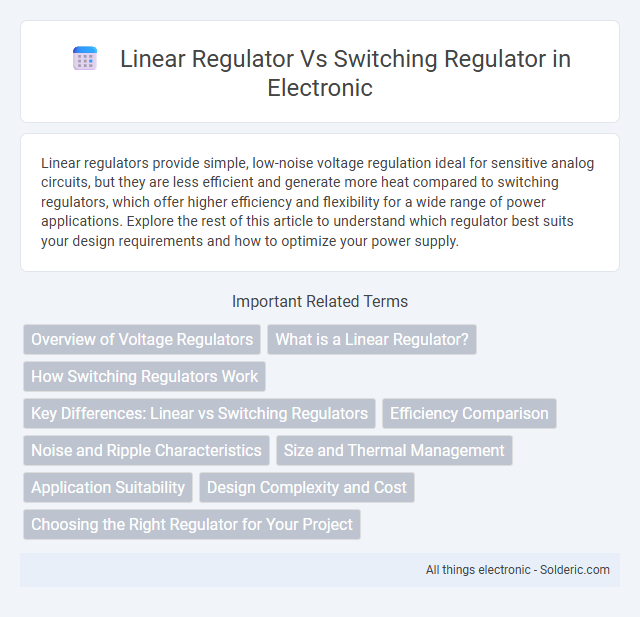Linear regulators provide simple, low-noise voltage regulation ideal for sensitive analog circuits, but they are less efficient and generate more heat compared to switching regulators, which offer higher efficiency and flexibility for a wide range of power applications. Explore the rest of this article to understand which regulator best suits your design requirements and how to optimize your power supply.
Comparison Table
| Feature | Linear Regulator | Switching Regulator |
|---|---|---|
| Efficiency | Low (typically 40-60%) | High (up to 90% or more) |
| Output Noise | Low ripple and noise | Higher ripple, needs filtering |
| Complexity | Simple design, fewer components | Complex circuit, more components |
| Size | Larger heat sink required | Compact size possible |
| Heat Dissipation | High heat generation | Lower heat generation |
| Input Voltage Range | Limited, must be higher than output | Wide input voltage range |
| Cost | Lower initial cost | Higher initial cost |
| Application | Low power, noise-sensitive circuits | High power, battery-powered devices |
Overview of Voltage Regulators
Voltage regulators maintain a constant output voltage regardless of input voltage fluctuations and load variations, ensuring stable performance for electronic devices. Linear regulators use a variable resistance to drop excess voltage, providing low noise and simplicity but lower efficiency, especially with significant voltage differences. Switching regulators convert input voltage through high-frequency switching and energy storage elements, achieving higher efficiency and better heat management suitable for demanding applications.
What is a Linear Regulator?
A linear regulator is a type of voltage regulator that maintains a constant output voltage by dissipating excess power as heat through a pass transistor operating in its linear region. It provides low noise and fast transient response, making it ideal for sensitive analog and RF applications where clean power is essential. Your choice of a linear regulator ensures simplicity and reliability in low dropout voltage scenarios but may suffer from lower efficiency compared to switching regulators.
How Switching Regulators Work
Switching regulators efficiently convert voltage by rapidly switching on and off, storing energy in inductors and capacitors to regulate output voltage with minimal power loss. Unlike linear regulators that dissipate excess voltage as heat, switching regulators use high-frequency pulses to maintain stable voltage, improving energy efficiency especially in battery-powered devices. Your choice of switching regulator can optimize power management in applications requiring compact size, low heat generation, and high efficiency.
Key Differences: Linear vs Switching Regulators
Linear regulators provide a simple, low-noise solution by dissipating excess voltage as heat, making them ideal for low-power applications with minimal efficiency requirements. Switching regulators offer higher efficiency by rapidly switching components on and off, converting power through inductors or capacitors, which suits high-power or battery-operated devices needing optimal energy use. Your choice depends on the trade-offs between efficiency, noise, size, and thermal management in your specific electronic design.
Efficiency Comparison
Linear regulators typically offer efficiency ranging from 30% to 60%, as they dissipate excess voltage as heat, making them less suitable for high voltage drops or high current applications. Switching regulators achieve efficiency levels between 80% and 95% by converting power through inductors, capacitors, and switches, significantly reducing energy loss. This efficiency advantage makes switching regulators ideal for battery-powered devices and systems requiring minimal heat dissipation.
Noise and Ripple Characteristics
Linear regulators provide low noise and minimal ripple output due to their continuous conduction mode, making them ideal for sensitive analog circuits. Switching regulators, while more efficient and capable of handling higher power, generate higher noise and ripple because of their high-frequency switching action, often necessitating additional filtering to maintain signal integrity. Your choice depends on the noise tolerance of your application versus the efficiency and power requirements.
Size and Thermal Management
Linear regulators offer a compact design ideal for applications with minimal space constraints but generate significant heat due to voltage drop, requiring efficient thermal management like heat sinks. Switching regulators are generally larger due to additional components like inductors and capacitors, yet they operate with higher efficiency, producing less heat and simplifying thermal design. Thermal management in switching regulators is often easier despite their size, making them suitable for high-power applications where heat dissipation is critical.
Application Suitability
Linear regulators are ideal for low-noise, low-power applications such as audio equipment, precision analog circuits, and battery-powered devices due to their simple design and minimal electromagnetic interference. Switching regulators are better suited for high-efficiency, high-power applications like power supplies in computers, telecommunications, and automotive systems where energy conservation and heat dissipation are critical. The choice depends on factors such as voltage conversion efficiency, thermal management, and acceptable noise levels in the target application.
Design Complexity and Cost
Linear regulators offer simple design with minimal components, resulting in lower upfront costs and ease of implementation for low-power applications. Switching regulators involve complex circuit designs including inductors, capacitors, and control ICs, increasing both design time and component expenses. The higher initial cost of switching regulators is often justified by their superior efficiency and ability to handle higher power levels.
Choosing the Right Regulator for Your Project
Choosing the right regulator for your project depends on factors like efficiency, noise tolerance, and power requirements. Linear regulators provide low noise and simplicity, making them ideal for low-power, sensitive analog circuits, while switching regulators offer higher efficiency and better heat dissipation for high-power applications. Assess your system's voltage input, output load, and thermal constraints to determine if a linear or switching regulator best suits your needs.
Linear regulator vs Switching regulator Infographic

 solderic.com
solderic.com